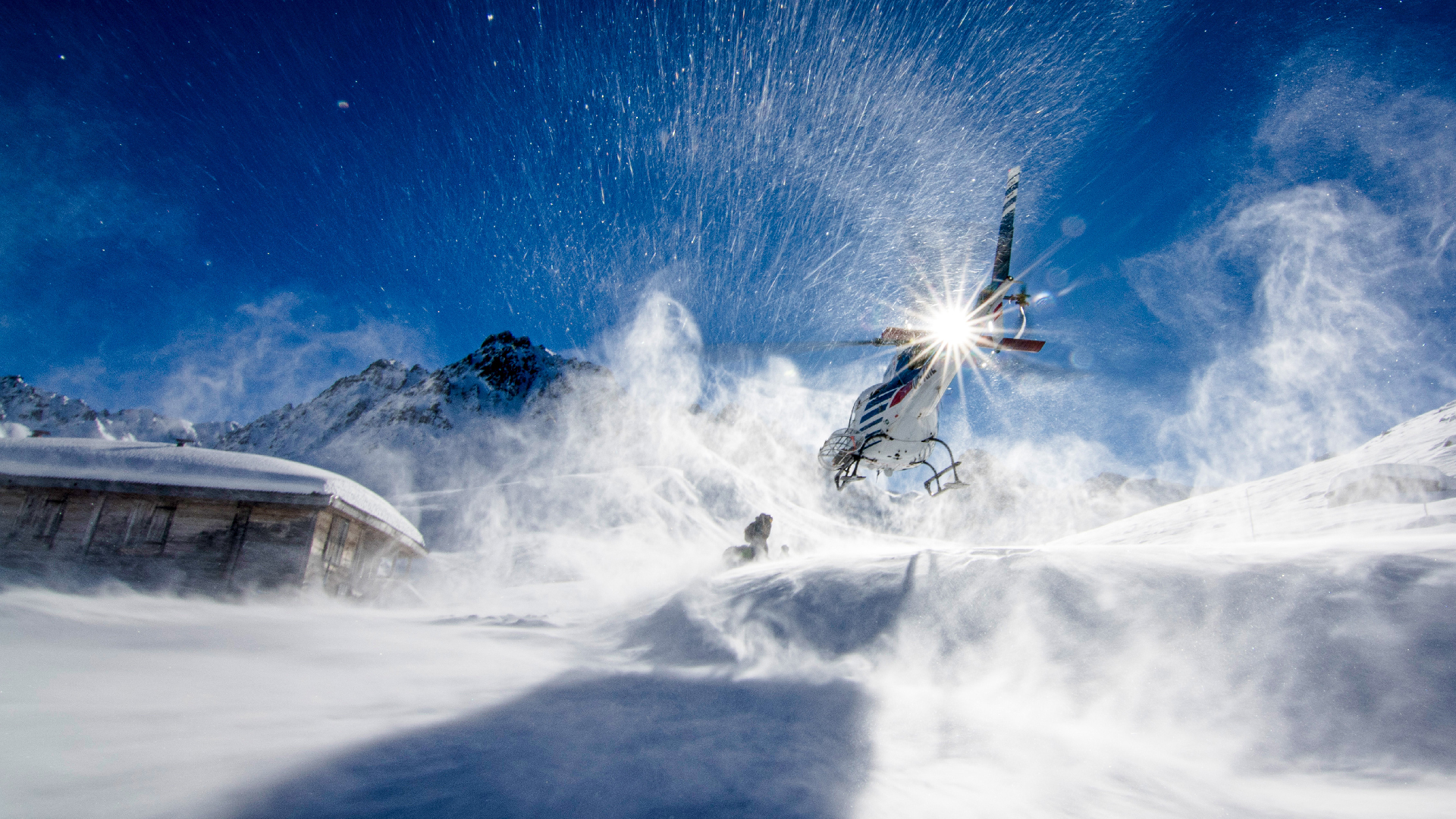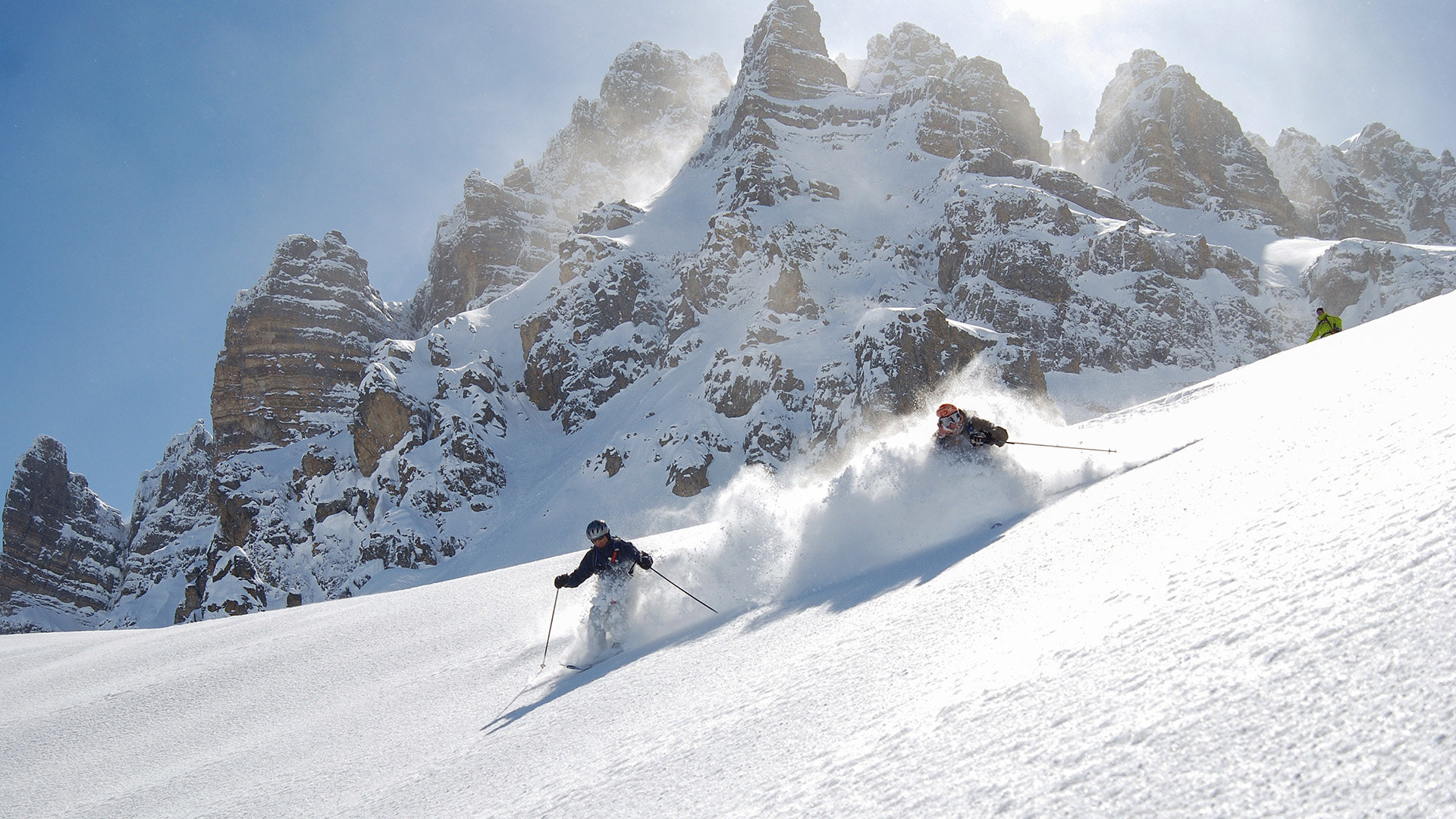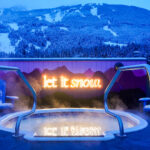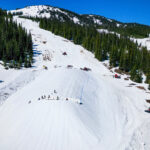
BRIDGING EUROPE AND ASIA, TÜRKIYE HAS ALWAYS BEEN A GOOD PLACE TO BASE AN ARMY. IT TURNS OUT IT’S ALSO A GOOD PLACE TO BASE A HELI-SKI OPERATION.
It was Friday night at Turkey Heliski when the rumours started circulating. We were about 80km from the Georgian border and not far from where the Russian military was scrambling to find pieces of the U.S. reaper drone brought down in the Black Sea a few days earlier. Hushed talk at après-ski was about some vacuum-packed contraband that had arrived in a guest’s ski bag.
In the din of a nearby minaret wailing the evening’s call to prayer, there were murmurs of more than five kilos being smuggled in.
We knew something was definitely up when wafts from the kitchen at our HQ, Haşimoğlu Hotel, began to reach our noses. All week, the dinner buffet had been tantalizing us far beyond our expectations of Turkish street food like döner kebabs and baklavas. Instead, local specialties—Akçaabat meatballs, eggplant saksuka, gozleme pastries and hamsi (anchovy) pilav—had us refilling our plates. Tonight’s aroma, however, wasn’t so much unique as out of place.

…everyone who was skinning was dutifully following a single-tracked line to a distant col. So Swiss.

Confirmation finally arrived when Tobias and Lorenz, our Swiss pilots, announced to the small crowd excitedly, “We’ve had a secret delivery: Tonight is Raclette Night!”
For the last 10 winters, Switzerland-based Turkey Heliski has been bringing in not just pilots, but also mountain guides, office personnel, and sometimes raclette cheese, to the impressive Kaçkar Massif in the Pontic Alps. The aircraft and mechanics come from Austria. Powder-pilgrims come from across Europe and, increasingly, from North America. The snow, lots and lots and lots of it, comes from the Black Sea.
With a tenure of more than 5,000 square kilometres in the country now officially known as Türkiye, heli-skiers share their domain with no one else. The highest peaks reach almost 4,000m, and are home to more than 400 named runs with typical skiable verticals of 700-1,200m. Two A-Star helicopters lift off each morning a few metres from the breakfast table in the mountain village of Ayder, one reserved for a private group of four skiers and another shared by up to 16.
BIG TENURE, SMALL WORLD
My wife Ray and I shared ski days and dinners with our new Bulgarian friends, Stoyan and Hristo, whose English, topics of conversation and senses of humour were more entertaining than that of most North Americans. Having heli-skied in Alaska and British Columbia multiple times, they were finally trying Türkiye. Like a typical pair of dads and ski buddies you’d find in a helicopter or snowcat in B.C., discerning businessman Hristo had an INSEAD MBA while lawyer Stoyan’s Instagram videos from countless feather-in-cap ski destinations were intermingled with clips of him bouncing on trampolines with his kids. The four of us shared the helicopter with two other groups of four from France and Switzerland.
In one of many small-world moments, it turned out lovely Laura, our smiley and patient mountain guide, was born and raised under the shadow of the Eiger in Grindelwald, Switzerland. Less than two weeks earlier, I’d been ski-touring in her backyard and when I showed her some photos she blurted out: “Oh! You were skiing with Sigi, she’s one of my best friends!” Sigi was equally surprised when Laura and I texted her a few selfies.
With the appropriate mountain ranges, volcanoes and climate, Türkiye has a long, wintery history of alpine skiing and today has more than 40 ski areas and resorts in different mountain regions. Five years earlier, we’d skied the massive inactive volcano Erciyes near fabled tourist mecca Cappadocia, and were so impressed by its newly built infrastructure, high-speed lifts, lux accomms and seemingly endless ski-touring we’d always wanted to return.

YO-YO, FAST LAPS
As we all know, a skier’s ultimate high-speed lift is a helicopter, so on this trip we spent most of our days yo-yoing fast laps above the treeline. Regular snowfall here comes with storms that typically start off more maritime-moist before finishing dry and continental, a great combo for stability. Like most heli-ski hotspots, the cake is topped frequently by Black Sea precipitation and this consistency is one of the many draws to Turkey Heliski.
Mountain guide and Turkey Heliski’s senior partner Thierry Gasser pointed out one of the many peculiarities of the Kaçkar Mountains that make them “cut for heli-skiing.” Said Gasser: “It’s possible to ski everywhere in each valley with varied terrain, and flight times between runs or from the lodge to the terrain are very short.”
Like all great heli-skiing operations, most run names have a story. The one called Just After Corfu, for instance, received its moniker after a flight crew and aircraft had to spend two days stuck on the Greek island waiting out a massive storm. Guests’ first tracks were thigh-deep.
A female theme runs in one valley: Pretty Woman, Easy Woman, and so on. The original was inspired by one lucky client on a first descent who was so impressed by the silence, he named it: No Woman, No Cry.
Cosmic Debris seemed appropriate (for the enormous rock blocks that we skied around mid-slope) and Face à la Mer (In Front of the Sea) for its spectacular views of the Black Sea, with the Caucasus Mountains in the distance.
Of course, not every ski writer can time his or her visit perfectly and many times over the decades I’ve heard the apologetic “It’s not normally like this!” weather speech. Our visit in late March began with spring corn and sunshine before an unusually warm front entered the scene dramatically, complete with Saharan sand that painted the western faces orange and spoiled our dreams of bottomless Anatolian powder.
Less than a week later, the painful photos and messages began arriving in my inbox. While we were then in the south of Turkey scrambling about the ruins of Ephesus, visiting the Virgin Mary’s death house near Izmir and getting scrubbed down in a 500-year-old hammam on our Turkey Adventure Part II, the Black Sea gods had already wiped the slate clean with 70cms, enabling that week’s lucky clients to enjoy a Turkish delight.
GO TÜRKIYE
Heli Packages
Turkey Heliski’s season is similar to North American operations. Typical ski weeks run seven days with guaranteed 30,500 metres of vertical in semi-private groups of four with IFMGA mountain guides. Eight nights’ accommodation, all meals and snacks, airbag, radio, avy pack, airport transfers: €8,650. Three-day packages are also available. turkey-heliski.pro
Turkish Airlines
Turkish Airlines, one of the world’s finest, and with more international destinations than any other, flies nonstop to Istanbul from Toronto, Vancouver and Montreal with onward flights to the brand new Rize International Airport that juts out into the Black Sea, about a 40-minute drive to the mountain village of Ayder and Turkey Heliski. turkishairlines.com
Side Hustles
Clear room on your phone storage for photos. Before and after your ski trip, Turkish distractions are spectacular, varied and too numerous to count. With a history that ranges from cavemen to the Cold War, unique active outdoor adventures in all directions, gastronomy that will leave you taking notes, and friendly faces, you should plan more than skiing. And to top it off, winter is an ideal time to visit. goturkiye.com




